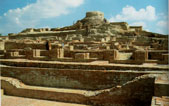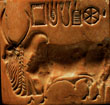Indus
Civilization |
This land also witnessed
the glorious era of Indus civilization about 8000 years B.C when the first village was
found at Mehargarh in the Sibi District of Balochistan comparable with the earliest
villages of Jericho in Palestine and Jarmo in Iraq. Here,
during the last decade i.e., 1980’s, the French and Pakistani archaeologists have
excavated mud built houses of the Mehargarh people and their agricultural land known for
the cultivation of maize and wheat, together with polished stone tools, beads and other
ornaments, painted jars and bowls, drinking glasses, dishes and plates.
|

Site of Moenjodaro |
| The archaeologists believe that by 7000 B.C.,
the Mehargarh people learnt to use the metal for the first time. From the first revolution
of agricultural life the man moved to another great revolution in his social, cultural and
economic life. He established trade relations with the people of Turkmenistan, Uzbekistan,
Iran and the Arab world. He not only specialized in painting different designs of pottery,
made varieties of pots and used cotton and wool but also made terracotta figurines and
imported precious stones from Afghanistan and Central Asia. This early bronze age Culture
spread out in the countryside of Sindh, Balochistan, Punjab and North West Frontier
Province of Pakistan. |
Indus Art Gallery |

Priest King
of Moenjodaro
|
Indus Art Gallery |
|
|
| This early beginning led to the concentration
of population into the small towns, such as Kot Diji in Sindh and Rahman Dheri in Dera
Ismail Khan district. It is this social and cultural exchange that led to the rise of the
famous cities of Moenjodaro and Harappa, with largest concentration of population
including artisans, craftsmen, businessmen and rulers.This culminated in the peak of the
Indus Civilization which was primarily based on intensively irrigated agricultural land
and overseas trade and contact with Iran, Gulf States, Mesopotamia and Egypt. Dames were
built for storing river water, land was cultivated by means of bullock-harnessed plough -
a system which still prevails in Pakistan, granaries for food storage were built, furnace
was used for controlling temperature for |

Indus Seal of Bull |
| making red pottery and various kinds of
ornaments, beads of carnelian, agate, and terracotta were pierced through and above all
they traded their finished goods with Central Asia and Arab world. It is these trade
dividends that enriched the urban populace who developed a new sense of moral honesty,
discipline and cleanliness combined with a social stratification in which the priests and
the mercantile class dominated the society. The picture of high civilization can be
gathered only by looking at the city of Moenjodaro, the First Planned City in the World,
in which the streets are aligned straight, parallel to each other with cross streets
cutting at right angles. It is through these wide streets that wheeled carriages, drawn by
bulls or asses, moved about, carrying well-adorned persons seated on them appreciating the
closely aligned houses made of pucca-bricks, all running straight along the streets. And
then through the middle of the streets ran stone dressed drains covered with stone slabs -
a practice of keeping the streets clean from polluted water, seen for the first time in
the world. |
The legacy of our predecessors at the time of our independence, on August 14, 1947, came
to us as a treasure which may be called as Pakistan’s national heritage. So rich and
diversified is this heritage that Pakistani nation can be proud of its glorious past, be
Islamic, Post Islamic or pre-Islamic period as far back as pre-historic times. No other
country of the world can produce the treasure of by gone days as can be found in Pakistan.
It is now incumbent upon us to treasure our national heritage and save it from further
deterioration and theft.
The establishment of
NFCH is much appreciated and a great interest is shown by the general public hence since
its establishment in 1994 hundreds of proposals were received from different agencies and
individuals for the conservation, preservation and publication of the Pakistan’s
national heritage. It is hoped that with the continued patronage of the government, the
Philanthropists and the Business Community to the NFCH we shall be able to achieve the
aforesaid goal. |
Another
important settlement of Indus is Harappa
Click here for
HARAPPA
|


